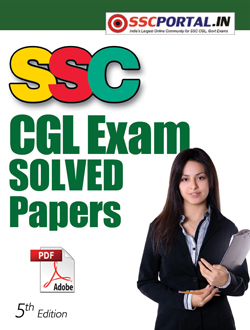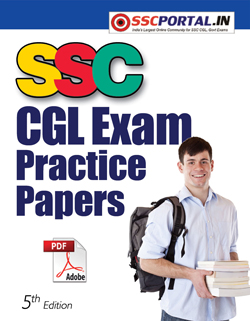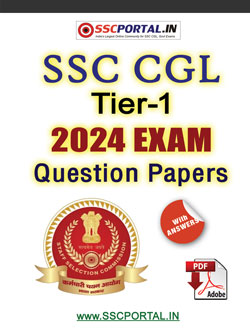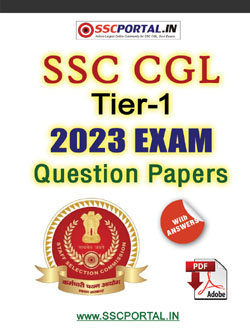NEW! SSC CGL PDF NOTES
SSC: Combined Graduate Level Examination : Syllabus [Tier-1] "Updated"
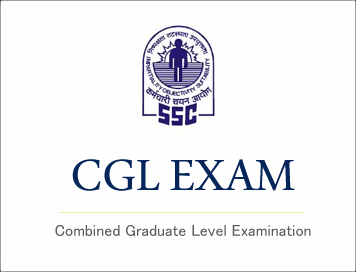
(Indicative Syllabus) SSC Combined Graduate Level (CGL) Exam
Indicative Syllabus:
Tier-I:
- General Intelligence & Reasoning: It would include questions of both verbal and non-verbal type. This component may include questions on analogies, similarities and differences, space visualization, spatial orientation, problem solving, analysis, judgment, decision making, visualmemory, discrimination, observation, relationship concepts, arithmetical reasoning and figural classification, arithmetic number series, non-verbal series, coding and decoding, statement conclusion, syllogistic reasoning etc. The topics are, Semantic Analogy, Symbolic/ Number Analogy, Figural Analogy, Semantic Classification, Symbolic/ Number Classification, Figural Classification, Semantic Series, Number Series, Figural Series, Problem Solving, Word Building, Coding & de-coding, Numerical Operations, symbolic Operations, Trends, Space Orientation, Space Visualization, Venn Diagrams, Drawing inferences, Punched hole/ pattern- folding & un-folding, Figural Pattern- folding and completion, Indexing, Address matching, Date & city matching, Classification of centre codes/roll numbers, Small & Capital letters/ numbers coding, decoding and classification, Embedded Figures, Critical thinking, Emotional Intelligence, Social Intelligence, Other sub-topics, if any.
- General Awareness: Questions in this component will be aimed at testing the candidates‟ general awareness of the environment around him and its application to society. Questions will also be designed to test knowledge of current events and of such matters of every day observations and experience in their scientific aspect as may be expected of any educated person. The test will also include questions relating to India and its neighbouring countries especially pertaining History, Culture, Geography, Economic Scene, General Policy & Scientific Research.
- Quantitative Aptitude: The questions will be designed to test the ability of appropriate use of numbers and number sense of the candidate. The scope of the test will be computation of whole numbers, decimals, fractions and relationships between numbers, Percentage. Ratio & Proportion, Square roots, Averages, Interest, Profit and Loss, Discount, Partnership Business, Mixture and Alligation, Time and distance, Time & Work, Basic algebraic identities of School Algebra & Elementary surds, Graphs of Linear Equations, Triangle and its various kinds of centres, Congruence and similarity of triangles, Circle and its chords, tangents, angles subtended by chords of a circle, common tangents to two or more circles, Triangle, Quadrilaterals, Regular Polygons, Circle, Right Prism, Right Circular Cone, Right Circular Cylinder, Sphere, Hemispheres, Rectangular Parallelepiped, Regular Right Pyramid with triangular or square base, Trigonometric ratio, Degree and Radian Measures, Standard Identities, Complementary angles, Heights and Distances, Histogram, Frequency polygon, Bar diagram & Pie chart.
- English Comprehension: Candidates‟ ability to understand correct English, his/ her basic comprehension and writing ability, etc. would be tested.
- The questions in Parts A, B, & D will be of a level commensurate with the essential qualification viz. Graduation and questions in Part-C will be of 10th standard level.
Indicative Syllabus (Tier-II):
Paper-I
- (Quantitative Abilities): The questions will be designed to test the ability of appropriate use of numbers and number sense of the candidate. The scope of the test will be the computation of whole numbers, decimals, fractions and relationships between numbers, Percentage, Ratio & Proportion, Square roots, Averages, Interest, Profit and Loss, Discount, Partnership Business, Mixture and Alligation, Time and distance, Time & Work, Basic algebraic identities of School Algebra & Elementary surds, Graphs of Linear Equations, Triangle and its various kinds of centres, Congruence and similarity of triangles, Circle and its chords, tangents, angles subtended by chords of a circle, common tangents to two or more circles, Triangle, Quadrilaterals, Regular Polygons, Circle, Right Prism, Right Circular Cone, Right Circular Cylinder, Sphere, Hemispheres, Rectangular Parallelepiped, Regular Right Pyramid with triangular or square base, Trigonometric ratio, Degree and Radian Measures, Standard Identities, Complementary angles, Heights and Distances, Histogram, Frequency polygon, Bar diagram & Pie chart.
Paper-II
- (English Language and Comprehension): Questions in this component will be designed to test the candidate‟s understanding and knowledge of English Language and will be based on spot the error, fill in the blanks, synonyms, antonyms, spelling/ detecting misspelled words,idioms & phrases, one word substitution, improvement of sentences, active/ passive voice of verbs, conversion into direct/ indirect narration, shuffling of sentence parts, shuffling of sentences in a passage, cloze passage & comprehension passage.
Paper-III (Statistics):
- Collection, Classification and Presentation of Statistical Data – Primary and Secondary data, Methods of data collection; Tabulation of data; Graphs and charts; Frequency distributions; Diagrammatic presentation of frequency distributions.
- Measures of Central Tendency- Common measures of central tendency – mean median and mode; Partition values- quartiles, deciles, percentiles.
- Measures of Dispersion- Common measures dispersion – range, quartile deviations, mean deviation and standard deviation; Measures of relative dispersion.
- Moments, Skewness and Kurtosis – Different types of moments and their relationship; meaning of skewness and kurtosis; different measures of skewness and kurtosis.
- Correlation and Regression – Scatter diagram; simple correlation coefficient; simple regression lines; Spearman‟s rank correlation; Measures of association of attributes; Multiple regression; Multiple and partial correlation (For three variables only).
- Probability Theory – Meaning of probability; Different definitions of probability; Conditional probability; Compound probability; Independent events; Bayes‟ theorem.
- Random Variable and Probability Distributions – Random variable; Probability functions; Expectation and Variance of a random variable; Higher moments of a random variable; Binomial, Poisson, Normal and Exponential distributions; Joint distribution of two random variable (discrete).
- Sampling Theory – Concept of population and sample; Parameter and statistic, Sampling and non-sampling errors; Probability and nonprobability sampling techniques(simple random sampling, stratified sampling, multistage sampling, multiphase sampling, cluster sampling, systematic sampling, purposive sampling, convenience sampling and quota sampling); Sampling distribution(statement only); Sample size decisions.
- Statistical Inference - Point estimation and interval estimation, Properties of a good estimator, Methods of estimation (Moments method, Maximum likelihood method, Least squares method), Testing of hypothesis, Basic concept of testing, Small sample and large sample tests, Tests based on Z, t, Chi-square and F statistic, Confidence intervals.
- Analysis of Variance - Analysis of one-way classified data and twoway classified data.
- Time Series Analysis - Components of time series, Determinations of trend component by different methods, Measurement of seasonal variation by different methods.
- Index Numbers - Meaning of Index Numbers, Problems in the construction of index numbers, Types of index number, Different formulae, Base shifting and splicing of index numbers, Cost of living Index Numbers, Uses of Index Numbers.
Paper-IV
- (General Studies-Finance and Economics):
Part A:
- Finance and Accounts-(80 marks):
- Fundamental principles and basic concept of Accounting:
- Financial Accounting: Nature and scope, Limitations of Financial Accounting, Basic concepts and Conventions, Generally Accepted Accounting Principles.
- Basic concepts of accounting: Single and double entry, Books of original Entry, Bank Reconciliation, Journal, ledgers, Trial Balance, Rectification of Errors, Manufacturing, Trading, Profit & loss Appropriation Accounts, Balance Sheet Distinction between Capital and Revenue Expenditure, Depreciation Accounting, Valuation of Inventories, Non-profit organisations Accounts, Receipts and Payments and Income & Expenditure Accounts, Bills of Exchange, Self Balancing Ledgers.
Part B:
- Economics and Governance-(120 marks):
- Comptroller & Auditor General of India- Constitutional provisions, Role and responsibility.
- Finance Commission-Role and functions.
- Basic Concept of Economics and introduction to Micro Economics: Definition, scope and nature of Economics, Methods of economic study and Central problems of an economy and Production possibilities curve.
- Theory of Demand and Supply: Meaning and determinants of demand, Law of demand and Elasticity of demand, Price, income and cross elasticity; Theory of consumer‟s behaviourMarshallian approach and Indifference curve approach, Meaning and determinants of supply, Law of supply and Elasticity of Supply.
- Theory of Production and cost: Meaning and Factors of production; Laws of production- Law of variable proportions and Laws of returns to scale.
- Forms of Market and price determination in different markets: Various forms of markets-Perfect Competition, Monopoly, Monopolistic Competition and Oligopoly ad Price determination in these markets.
Indian Economy:
- Nature of the Indian Economy Role of different sectorsRole of Agriculture, Industry and Services-their problems and growth;
- National Income of India-Concepts of national income, Different methods of measuring national income.
- Population-Its size, rate of growth and its implication on economic growth.
- Poverty and unemployment- Absolute and relative poverty, types, causes and incidence of unemployment.
- Infrastructure-Energy, Transportation, Communication.
- Economic Reforms in India: Economic reforms since 1991; Liberalisation, Privatisation, Globalisation and Disinvestment.
Money and Banking:
- Monetary/ Fiscal policy- Role and functions of Reserve Bank of India; functions of commercial Banks/RRB/Payment Banks.
- Budget and Fiscal deficits and Balance of payments.
- Fiscal Responsibility and Budget Management Act, 2003.
Role of Information Technology in Governance.
- Questions in Paper-I will be of Matriculation Level, Paper-II of 10+2 Level and in Paper-III and Paper-IV of Graduation Level.
Skill Test:
Date Entry Skill Test (DEST):
- For the post of Tax Assistants (Central Excise & Income Tax): Data Entry Speed Test (DEST) at 8,000 (eight thousand) Key Depression per hour on Computer.
- The “Data Entry Speed Test” Skill Test will be conducted for a passage of about 2000 (two thousand) key depressions for a duration of 15 (fifteen) minutes. This test will be of qualifying nature. Computers for the test will be provided by the Commission at the Centre/ venue notified for the purpose. The Skill Test will be held at the Commission‟s Regional/ Sub-Regional Offices or at other Centres as may be decided by the commission. Detailed instructions regarding Skill Test will be sent by the Regional/ Sub Regional Offices of the Commission to eligible candidates declared qualified for appearing in Skill Test. Information about evaluation of Typing Test/ DEST are available on the Commission‟s website https:\\ssc.nic.in (Candidate‟s Corner).
- The Skill test will be conducted in the manner decided by the Commission for the purpose.
- OH candidates opting for the post of Tax Assistant in CBDT are exempted for appearing in Skill Test. OH candidates opting for post of Tax Assistant in CBEC are not exempted from Skill Test. HH and VH candidates are not eligible for exemption from the Skill Test.
- PwD candidates who are eligible for scribes as para-7.1 and 7.2 of the Notice of Examination will be allowed additional compensatory time of 5 (five) minutes in DEST. Only those VH candidates who opt for scribes in the written examination will be provided passagereader at the time of Skill Test.
Computer Proficiency Test (CPT):
- The Commission will hold Computer Proficiency Test (CPT), comprising of three modules: (i) Word Processing, (ii) Spread Sheet and (iii) Generation of Slides, for the posts of Assistant Section Officer in CSS, MEA & AFHQ, Assistant in Serious Fraud Investigation Office (SFIO) under the Ministry of Corporate Affairs, Assistant (GSI) in the Ministry of Mines, Inspector (Central Excise), Inspector (Preventive Officer) & Inspector (Examiner) in CBIC. The CPT will be conducted in the manner decided by the Commission for the purpose. No exemption from CPT is allowed for any category of PwD candidates. CPT will be of qualifying nature.
- Detailed instructions regarding CPT will be provided by the Regional/ Sub Regional Offices of the Commission to eligible candidates declared qualified for appearing in the CPT.
Study Material for Combined Graduate Level CGL Examination
<< Go back to Main Page
Courtesy: SSC


